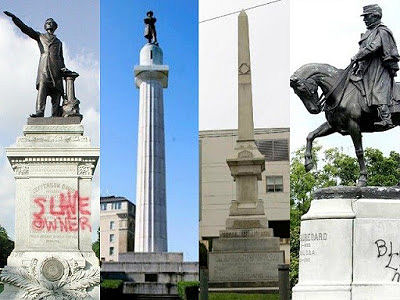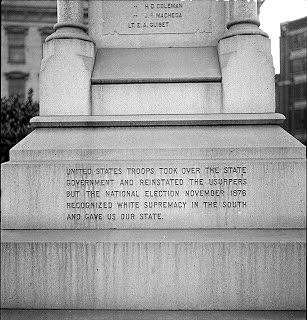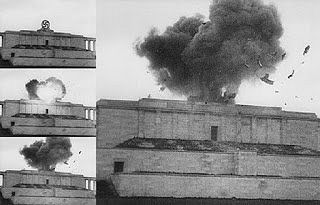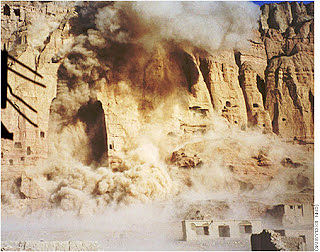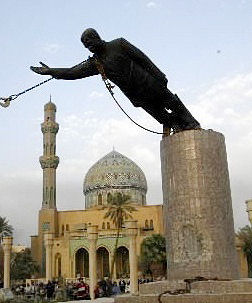The Politics of Removal
Unmitigated drivel about public art, architecture and monuments make up a large percentage of Laws of Silence posts. From time to time we've talked about the destruction of past monuments to reflect changing aesthetics, political ideologies, practical urban renewal, etc. The erasure of the past for political reasons was common enough in ancient Rome and Egypt, where a succeeding emperor or pharaoh would efface inscriptions on monuments in order to diminish the achievements of a rival or to simply to sully their names.
A few days ago, the New Orleans City Council voted for an ordinance that will lead to the removal of four monuments in that city which honor Confederate heroes. The Atlantic says:
This decision constitutes the most sweeping removal of Confederate iconography since the lowering of the Confederate battle flag in Columbia, South Carolina, this past summer, and offers the clearest evidence yet that the Lost Cause view of the Civil War has finally lost.
It is in the larger historical context that we view this news. New Orleans feels confident it can remove four big monuments and in no way be diminished, a definitive sign of the changing of the guard.
Louisiana's governor even stepped into the fray and tried to block their removal, not because of the history they represent, but because they represent history. In an interesting twist, however, the Governor isn't some disgruntled old white dude. He's young, conservative and of Indian heritage -- Bobby Jindal.
I have no confusion over why people want these to come down. Hard to swallow walking past some tax-supported public art to glorify a man who fought a war to keep your people enslaved.
The removal is said to be temporary; the goal being to put them together in some kind of park or memorial where they can be re-contextualized. I always get a bit disconcerted by attempts to alter history, something Winston Smith-y about it, but if done correctly, I suppose the monuments can be preserved in a way that doesn't insult the large black population of the city.
One thing that stood out was that the monuments were brought down for being a "public nuisance." You'd think any nuisance would be a result of the actions of people, not inert marble and bronze. Also curious is that an anonymous donor is footing the bill; what are the donor's motives? Get rid of these things ASAP....or to protect them from destruction by attaching the condition that they'll foot the bill only if they are preserved?
Apparently there's a U.S. place names bureau that periodically changes official place names from time to time. This has included eliminating offensive racial epithets from creeks, mountains, towns, etc. Battle Creek, Oklahoma, for example, was known as Nigger Creek. Until 1990! The conundrum came up recently in France for a town called Mort aux Juifs: "Death to Jews" (residents voted to retain the name). In Spain, Arabs can't be too happy in Matamoros: Kill Moors.
I'm not against periodically updating place names to reflect changing attitudes, but I do wonder where it will stop.
A mental flash: as of 2016 the World Fantasy Award will no longer feature the likeness of H.P. Lovecraft because of his virulent racism; attitudes which even by the standards of his time were pretty harsh. This pissed off Lovecraft scholar S.T. Joshi, who said he returned his two WFAs and urged a boycott of future ceremonies. Like Jindal, Joshi is Indian, demonstrating that this issue is not just black and white....
Nor do I oppose taking out the confederate flag from state flags, which were only added in the 50's as a middle finger to Washington de-segregationists. By removing these confederate flags, it's not an attack on Southern heritage or Confederate dead, but an attack on Jim Crow.
I don't have any strong feelings against removing these four monuments in New Orleans, despite the money and manpower expended on such endeavors. But I'm uncomfortable with the destruction of historical monuments and buildings in general. And I wonder....Jefferson and Washington owned slaves, so will they eventually become targets? Because that's a totally different scale altogether, as improbable as it is unfeasible. It's like the debates in literature about Céline or Ezra Pound; do we refuse to acknowledge their place in the canon because they happened to be anti-Semites or fascist sympathizers?
I would propose that the answer doesn't lie in removing these monuments, but perhaps adding context, whether in the form of interpretive signs and markers, or some kind of counterbalance, a monument to show that there is the will to spend as much time and energy on honoring another person and ideology as there is on what's currently there.
This is all part and parcel of Art History. And this subject certainly merits close attention. I'd like to see a survey of what has been destroyed and removed instead of what's been created and installed. Who and what we honor, and how, are living polemics. The struggle over symbols is in this case also a struggle over urban space. As something tangible it is easier to quantify, to actually do something on a monumental scale that will alter the city-scape. One could call it the Politics of Removal.
I've always wondered when they'll go after that Pike statue in DC....
Removing four statues seems appropriate if you're aiming to re-orient a map -- one for each cardinal direction. The statues represent Gen. Robert E. Lee (1884), Pres. Jefferson Davis, Gen. Gustave Toutant Beauregard (also a Freemason) and the Crescent City White League (1891).
Of the four, the last is quite shocking. It doesn't honor politicians or generals. It commemorates a battle in which an army of about 5000 from the White League attempted to take over the state government in September 1874. It was the culmination of series of violent events stemming from a disputed 1872 election. The violence had already included the massacre of 220+ people, most of them black, at Colfax and around 30 people at Coushatta. It was essentially an extra-legal paramilitary working on behalf of the Democratic party to suppress the vote, harass carpetbaggers, intimidate blacks and above all regain control of the government. Unlike the KKK, the White League worked openly, without disguise. When the Democrats did regain control of the government in 1878, the militants in the White League were re-absorbed back into various state militias and the National Guard. The Klan was finally suppressed about this time under intense pressure from the Federal government.
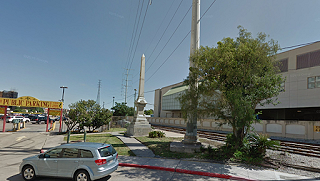 In the 20's and 30's the Klan re-appeared; it was an entirely different organization, but it had taken to mass parades and rallies as much as night riding. It was in this "2nd generation" that the Klan membership was historically at its highest, and perhaps most highly-influential.
In the 20's and 30's the Klan re-appeared; it was an entirely different organization, but it had taken to mass parades and rallies as much as night riding. It was in this "2nd generation" that the Klan membership was historically at its highest, and perhaps most highly-influential.
This could account for why an inscription was added to the monument in 1932 stating that the Yankees "recognized white supremacy in the South" by withdrawing Federal troops after the efforts of the White League. Note that the monument doesn't talk about recognizing "states rights" or the "legitimate grievances of Southerners resulting from the punitive measures of Reconstruction" which is how defenders of the monument and the confederate flag frame the aftermath of the Civil War. Nope, the monument celebrates Northern recognition of white supremacy. No surprise that a city which is 60% black would vote to bring it down.
To call for the removal of this inscription is not being "politically correct". This is not "college student crybaby" stuff. This is about repudiating a publicly-funded tribute to the openly white supremacist paramilitaries which took control of the government and established the laws which defined blacks as second-class citizens for the next hundred years.
This flat-out racist monument graced New Orleans until 1989. At that time, it was removed in order to do work on Canal Street. City leaders probably hoped to mothball it, but some angry citizens kicked into gear and had it re-erected. In 1993 it was moved to the spot where the battle actually took place, which had the side benefit of being somewhat out of the way, silenced to some degree. The original inscription was covered up with another slab and a more conciliatory inscription added.
Where it goes now is anybody's guess. Soon after the council's vote, various plaintiffs filed suit to block their removal: the Louisiana Landmarks Society, the Foundation for Historical Louisiana, the Monumental Task Committee Inc. and Beauregard Camp No. 130, a New Orleans chapter of the Sons of Confederate Veterans.
Of course, what happens will not be determined by questions regarding what we honor and how, but by legalities regarding who owns the land where they are situated, the fact that two of the monuments are on the National Register of Historic Places, and various laws protecting historical monuments and veterans memorials. Laws created, in other words, exactly for this kind of situation.
Winners writing history:
US 3rd Army blowing up swastika at the zeppelin field in Nuremberg, 1945
Taliban blowing up the Buddhas of Bamiyan, 2001.
A "spontaneous event" stage-managed by a US Psyops team. Firdos Square, 2003

